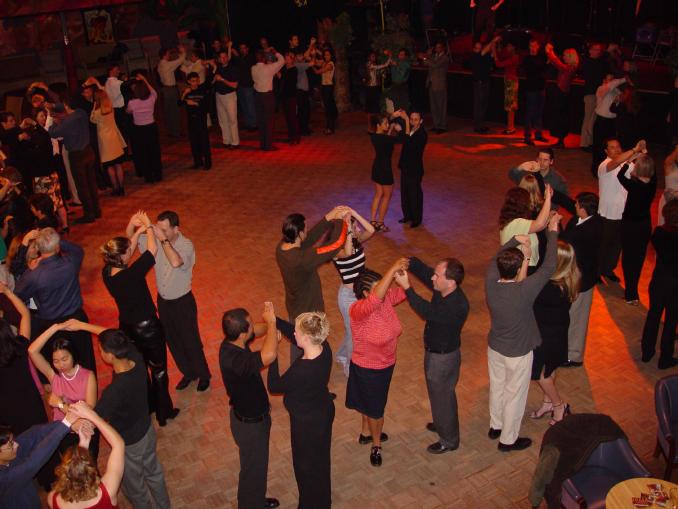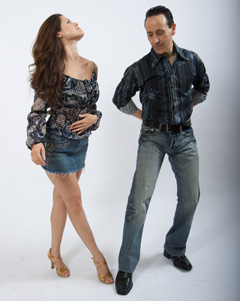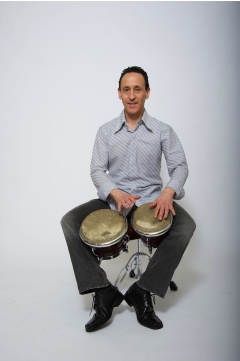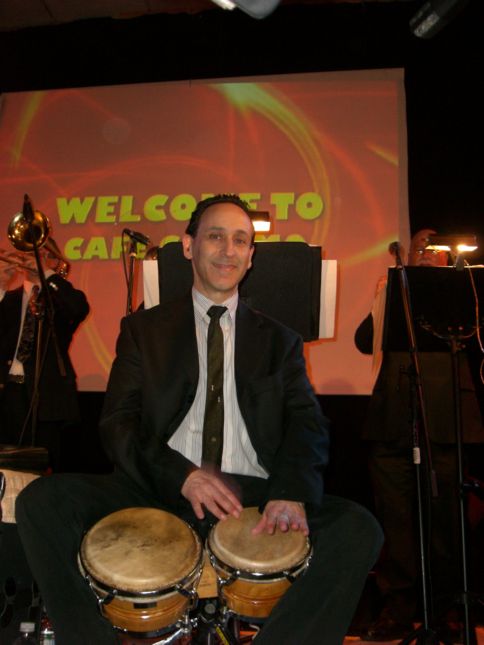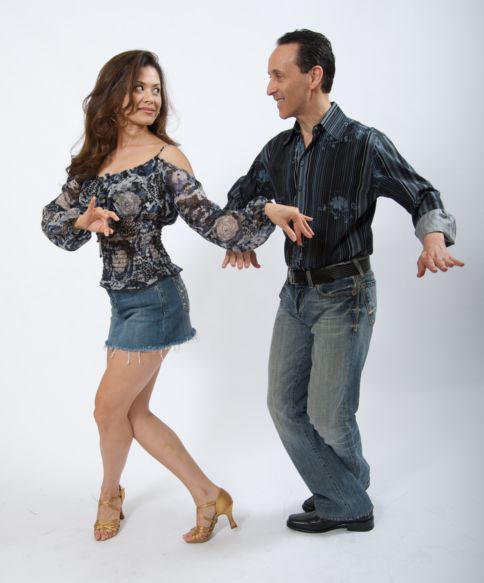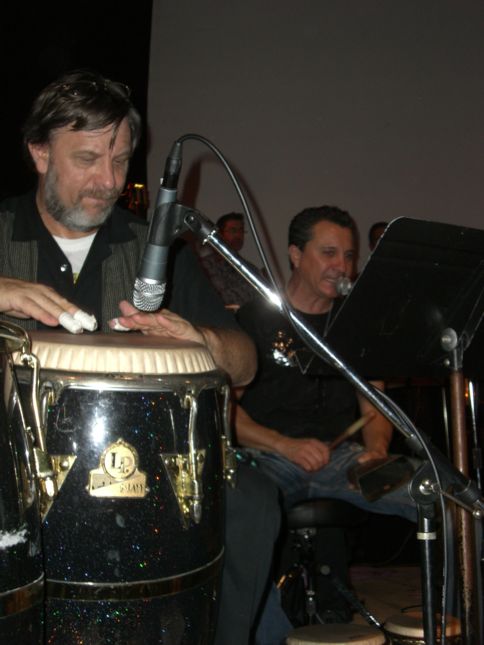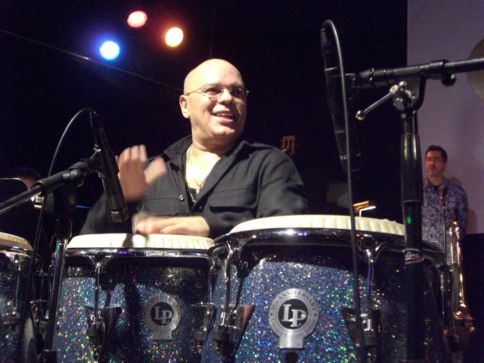Where's the Beat?!Audios, Videos, Tutorial, and Books
Hearing
the beats and understanding Salsa Rhythms and Counting
Jake's Boot Camp - online learning!
1 New Concept: Click here to read about this Salsa Instructional Site 
Salsa Instructional DVDs
2 SalsaCrazy Instructional DVDs: Click here for a discount through
SalsabyJake.com
Salsa Rhythm Tutorial on this site! (new!)
Check out this new Tutorial by Jake on basic latin music rhythms!
Books and Resources for Music
DO YOU NEED A SALSA / LATIN JAZZ BAND FOR YOUR PARTY OR EVENT!?!??
THEN PLEASE CONTACT JAKE THROUGH THIS WEB SITE! I can configure a great band for you of almost any size, and help with your entertainment..
Jake's Newsletter:
Where's
the damn Beat?!
Salsa dancers who are starting out sometimes have difficulty hearing where the beat is, and therefore they have trouble knowing when to start their steps. Basic music training can help (see books, website, and our new TUTORIAL below), plus you need to listen to the music a lot to become familiar with it. Salsa has many complex rhythms happening, and that can make it more of a challenge to hear the underlying musical beats. Counting helps and all dancers should be able to count out the rhythmic beat of the music. We dance "on the one" as do the majority of dancers in California. Different music emphasizes different beats, but it should not matter so much what you dance on so long as you and your partner are WITH the music and enjoy it. For instruction, we count the "8-count" (we used the "6-count" for years, but for uniformity with other teachers, most of whom use the 8-count, we switched in 2003 - See below for explanation.). For more information on the musical beats, and dance counts you hear in classes, check out the rhythms cheatsheet below. Read on if you have no musical experience and/or want more instruction on Music Theory and Salsa Rhythms....
You must understand where the musical beats are to be a dancer.
Dance is an expression of the
music using your own style and in effect, your body as another instrument. When
we count in class, it IS the music, since any dance step is meaningless
without the beats or count. Just as musicians count out music they
learn, dancers must count through patterns. Keeping that count during
the music is critical for being "on the beat". Once you have an idea
of where the beats are, the best way to become better at having the
count be automatic in your head is simply to LISTEN to a lot of music.
So, get yourself to the CD store or talk to the DJs or instructor to
be sure you can find plenty of music. As you become familiar with it,
the ability to express yourself during dance will also be enhanced... -Jake
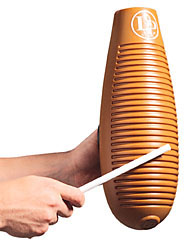 Jake's Salsa Rhythms Cheatsheet (Print Version)
Jake's Salsa Rhythms Cheatsheet (Print Version)
(requires Adobe PDF reader...):
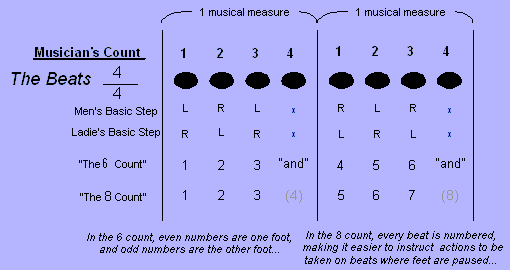
The difficulty some people have is relating the beats or counts to the music they hear. Salsa music is much more complex rhythmically than other types of music ( especially compared to Swing/Blues) because the percussion instruments play in contrast to one another (giving it the rich sound we love). As such, it can be difficult to hear where the measures begin (where the "1" is) shown in the cheatsheet. One thing you can do is to listen to the "voices" of the music, be they human or horns and see where they begin their phrases. Music is like speech in a way because it is made up of phrases, just like sentences are made up of phrases. Musicians write the music such that the phrases being around the first beat of a measure. It is not always on one - it may be just before or just after to make things more interesting - but the phrases generally are centered around one. So, listen to when the phrases start and try to pick up the musician's count (1,2,3,4) from that. All Salsa music is in 4/4 time. The bass also tends to emphasize both"one" and "three" in the music, which is why you see a lot of people in the clubs interchanging those two beats as a starting point for their basic step. While you should know the difference, you can typically get away with either in a club setting. (Note that the "on 2" style - based on the old Mambo step, and taught by some teachers now still has its first dance step on the first beat of the measure.)
One clever salsero put together a flash application called the "Salsa Beat Machine" which you can play with to understand how the different instruments contribute to the basic salsa rhythm, as we do below. If you'd like to try it out, visit the machine I saved by clicking SALSA BEAT MACHINE. Also, if you go to the HOME page of that site too, you'll see videos uploaded there by the creator that show graph(oscilloscope) of songs with the "1" notated visually and by a speaker. Nice..
![]() Back to TOP of page..
Back to TOP of page..
Salsa rhythm Tutorial in hearing the rhythm components
SalsabyJake.com has put together a short tutorial about Salsa music and understanding the basic rhythms.
A "timing tape", of which there are several available now, typically has someone counting along with the music or rhythm instruments. But this does not always help people really hear the beats because it is only counting by example. As I said above, there are many layers of rhythms in Salsa music, which make it more difficult for the untrained ear to hear the beat, as well of course as making the music great! The Salsa rhythms tutorial is contains explanations and short audio samples for step-by-step instruction to show you layer by layer how the rhythms come together to form the overall sound of salsa you hear.
Why learn about rhythms in such detail?? If you love to dance, and you want to connect to the music that you hear in the clubs, then a better understanding of that music is essential for that connection! The people that look the best on the dance floor connect to the musicians - dancing as they are playing - and this connection is what draws your attention (just as to the band). Feeling the connection is like being part of the band, and it allows you to express yourself rhythmically and have fun with the music.
Check out the Online Tutorial page for the salsa rhythms tutorial!
Check out a new web site where multiple dancers and musicians are contributing content to help you learn their secrets of how to dance to and understand Salsa music. JakesBootCamp.com Visit the ONLINE LEARNING page for more information!
Other Online resources
Berklee School of Music (Boston) Website
If you've ever wanted to attend a music school, then Berklee School of Music in Boston would be at the top of your list. It is an esteemed college of Music that has spawned many of the great talents in the music world. Recently, the college decided to share some of its courses online to make a statement that not all "file sharing" is bad. They have some basic courses in music theory, recording, the music business and even Afrro-Cuban percussion - which forms the basis for the music we dance to in Salsa Clubs.
Check out this new web site at BerkleeShares.com
For more specific sections that deal with basic rhythm and Afro-Cuban rhythms:
1. Rhythm Part I, by Paul Schmeling: PDF document introducing concepts of rhythm in music
2. Afro-Cuban Rhythm Lesson, by Ricardo Monzon: MP3 introduction to our rhythms
3. Afro Cuban Conga Rhythms, by Ricardo Monzon: Video intro to playing Congas
4. Latin Jazz Clave Lesson, by Victor Mendoza: Video intro to rhythm of Clave - the basis for all Latin music!
An online Guide to Salsa - 2013
As part of a class assignment, a group in L.A. produced this condensed guide to salsa dance and music in 2013. The musical section links back to my tutorial mentioned above. But it also has a number of other links that can be useful to new dancers. Check it out!
ONLINE GUIDE TO SALSA
OTHER ONLINE VIDEOS (Free):
There is an abundance of salsa timing snippets on YouTube available for free. Note that many of these are promos for paid courses. In a recent review, Jake chose the following ones as a good introduction to rhythms...
www.youtube.com/watch?v=CU-hEaCI1UE - the NY Jami Josephson timing tape - good explanation of basic timing, on1,on2 steps, demo with musical samples.
www.youtube.com/watch#!v=gm7JTBTas8Y - SalsaCrazy bootcamp basic step video - see DVDs for full videos
www.youtube.com/watch?v=bilkeB5hELg - with waveform and foot steps on-1 - not much explanation but a good visualization and quiz for your timing.
www.youtube.com/watch?v=q5FOwr-jDwQ - basic timing for beginners - with instruments - good explanations
The Salsa Beat Machine
One clever salsero put together a flash application called the "Salsa Beat Machine" which you can play with to understand how the different instruments contribute to the basic salsa rhythm, as we do below. If you'd like to try it out, visit the machine I saved by clicking HERE-SALSA BEAT MACHINE 
Enjoy!
Your computer must have the appropriate programs/plugins to view these documents.See web site for more information... Enjoy! -Jake
Books on Music Theory
Dancing to music, as one might expect, can benefit from knowledge of music. That being said, there are many dancers in the world that are not musically trained and many people can just develop a "feel" for the music or rhythms that form the basis for their dance. However, if you have trouble hearing the beats, then understanding the basics of music will definitely help. Below, we introduce you to a computer course that is designed specifically to break down Salsa music. In this section we have a list of several basic music theory books which could also be of interest:
"Understanding Clave and Clave Changes" by Kevin Moore (just released Nov 2011) explains the "Clave" - basis for all salsa and Latin music from beginning to more advance topics. Starts by just getting you to clap the clave with the beat, moves to dancing, and then clave changes. Musical samples included as well.
"Practical Theory Complete" by Sandy Feldstein is a self-instruction music theory course. It is very reasonably priced (usually $6 to $10) and may be found on Amazon.com or Barnes & Noble web sites. I have this book and it is pretty good. Starts at the beginning and has quite a bit of information.
"Music Theory Made Easy" by David Harp (about $6 on Amazon) has lots of positive reviews and it is inexpensive and useful.
"The Complete Idiots Guide to Music Theory" by Michael Miller for those of you who are fans of the Complete Idiot's series! (about $14 on Amazon)
Salsa Rhythms: NOTE: The books above discuss basic music theory so you can better understand the time signatures and musical measures in any type of music. Latin music has much more complicate rhythm components involved, and the eCourse below discusses many of these. . .
Books on Latin Music Rhythms and History
"Salsa Guidebook for Piano & Ensemble" by Rebeca Mauleon For people who are interested in digging deeper in the the rhythms that make up Salsa and other Latin music forms, this is the book. If you have some musical training (see books above), then reading this book will be easier. Rebeca digs into the history and development of the music, but the information is presented in a clear concise and practical way such that you can easily see what each instrument plays in a Salsa band and how the arrangements generally are performed. Highly recommended. Available at Amazon.com.
"Cuban Fire: History of Salsa and Latin Jazz" by Isabel LeyMarie - a great hostorical view by a musicologist with many great artists and their history in Latin music. A great read. Check out this book - available on Amazon.com.
Salsa Instructional Dance DVDs
Please visit the Instructional DVDs page for more information!
The 6-count vs. the 8-count... . . why we switched...
I utilized the 6-count ("1,2,3...4,5,6") in my teaching
for 10 years and I found that it had distinct advantages for teaching
people that are just starting to dance. (See
diagram below). The main advantage is that, by counting
steps the information about which foot to step on (left or right)
is contained in the count itself (even or odd). Further,
you can extend the count for patterns, which is why we count to
12 for patterns, and it makes it easier to find your way through
a pattern when learning. It also allows the teacher to say exactly
how many steps to take.
As for the 8-count ("1,2,3...5,6,7"), it is simply used by more
dance instructors now, and it has the advantage of numbering each beat, so
you can instruct what to do even on beats that you normally don't step (for
example, "lead the turn on 4"). Also, it is more useful
for advanced topics such as shine steps that occur on beats that the normal
basic is not danced. While either count works as a tool for learning, we've
changed to the 8-count, mainly in the interest of uniformity with the
other teachers in the Salsa community. That way, people will not get confused
when going from one class to another where different counts are utilized.
--Jake

![]() Back
to Top of SalsabyJake.com
Back
to Top of SalsabyJake.com
